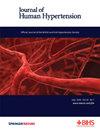High prevalence of elevated blood pressure (prehypertension) and hypertension among undergraduate university students in the UAE: a serious health concern
IF 2.7
4区 医学
Q2 PERIPHERAL VASCULAR DISEASE
引用次数: 0
Abstract
Hypertension, often referred to as a “silent killer,” due to its lack of obvious symptoms but can lead to devastating complications such as cardiovascular disease and stroke, particularly when left unmanaged. This highlights the importance of early screening of elevated blood pressure. The aim of this study is to determine the prevalence of elevated blood pressure (prehypertension) and hypertension among undergraduate university students, along with the associated risk factors. We recruited 344 randomly selected undergraduate students for a cross-sectional study. Blood pressure (BP) measurements were taken following best practice guidelines. In addition, body mass index (BMI) was measured, while other risk factors were collected through a questionnaire. Out of all participants, 36% exhibited elevated blood pressure, with the following breakdown: 15% (n = 51) had prehypertension, 18% (n = 62) had stage 1 hypertension, and 3% (n = 10) had stage 2 hypertension. The prevalence of hypertension and prehypertension was significantly higher among male students (52.7 and 100%, respectively) compared to female students (47.3, and 0% respectively). Significant correlations were found between blood pressure, BMI, and physical activity levels (P ≤ 0.001 and P ≤ 0.011, respectively). Our findings reveal a concerning prevalence of prehypertension and, to a greater extent, hypertension among undergraduate university students. Elevated blood pressure levels were strongly correlated with male gender, BMI, and physical activity levels. These results warrant further large-scale investigation and underscore the urgent need to raise awareness about this significant health risk in the younger population.

阿联酋大学本科生中血压升高(高血压前期)和高血压的高发率:一个严重的健康问题。
高血压通常被称为“沉默的杀手”,因为它没有明显的症状,但可以导致毁灭性的并发症,如心血管疾病和中风,特别是在不加以控制的情况下。这突出了早期高血压筛查的重要性。本研究的目的是确定高血压(高血压前期)和高血压在大学生中的患病率,以及相关的危险因素。我们随机招募了344名大学生进行横断面研究。按照最佳实践指南测量血压(BP)。此外,测量了身体质量指数(BMI),并通过问卷调查收集了其他危险因素。在所有参与者中,36%表现出血压升高,以下细分:15% (n = 51)为高血压前期,18% (n = 62)为1期高血压,3% (n = 10)为2期高血压。男生的高血压和高血压前期患病率(分别为52.7%和100%)明显高于女生(分别为47.3%和0%)。血压、BMI和体力活动水平之间存在显著相关性(P分别≤0.001和P≤0.011)。我们的研究结果揭示了高血压前期的患病率,在更大程度上,高血压在本科大学生中。血压水平升高与男性性别、身体质量指数和体力活动水平密切相关。这些结果值得进一步的大规模调查,并强调迫切需要提高对年轻人群中这一重大健康风险的认识。
本文章由计算机程序翻译,如有差异,请以英文原文为准。
求助全文
约1分钟内获得全文
求助全文
来源期刊

Journal of Human Hypertension
医学-外周血管病
CiteScore
5.20
自引率
3.70%
发文量
126
审稿时长
6-12 weeks
期刊介绍:
Journal of Human Hypertension is published monthly and is of interest to health care professionals who deal with hypertension (specialists, internists, primary care physicians) and public health workers. We believe that our patients benefit from robust scientific data that are based on well conducted clinical trials. We also believe that basic sciences are the foundations on which we build our knowledge of clinical conditions and their management. Towards this end, although we are primarily a clinical based journal, we also welcome suitable basic sciences studies that promote our understanding of human hypertension.
The journal aims to perform the dual role of increasing knowledge in the field of high blood pressure as well as improving the standard of care of patients. The editors will consider for publication all suitable papers dealing directly or indirectly with clinical aspects of hypertension, including but not limited to epidemiology, pathophysiology, therapeutics and basic sciences involving human subjects or tissues. We also consider papers from all specialties such as ophthalmology, cardiology, nephrology, obstetrics and stroke medicine that deal with the various aspects of hypertension and its complications.
 求助内容:
求助内容: 应助结果提醒方式:
应助结果提醒方式:


